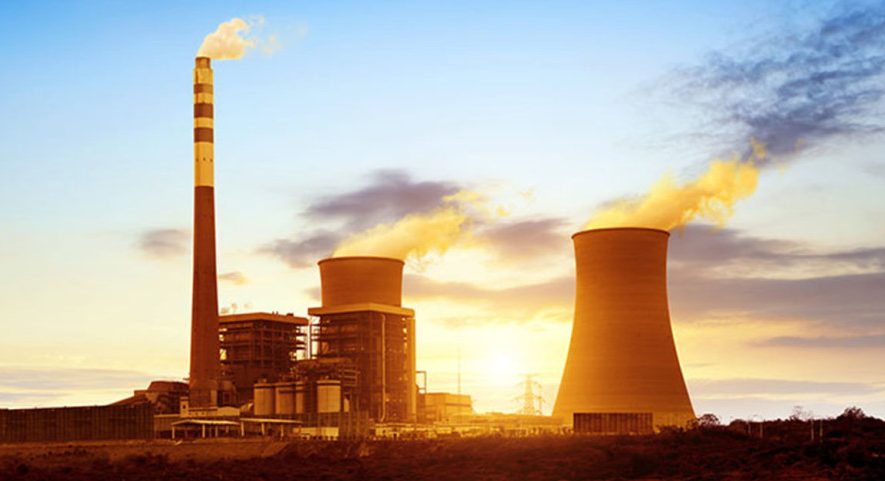Show almost anyone the yellow and black three-pronged nuclear emblem, and you will probably get a negative reaction. The symbol evokes feelings of impending doom, visions of mushroom clouds, and worries of radiation-borne maladies. But ironically, the energy behind it is the only thing that can avert catastrophe: the climate emergency.
Our current culture would have you believe that if coal and natural gas-based energy is the shadowy villain in civilization’s story, renewable resources are its knight in shining armor. However, renewable resources alone are not a feasible alternative to fossil fuels. Wind and solar’s current capacity factors are 24.9 percent and 35.4 percent, respectively. These capacities produce only a fraction of the energy they could if they ran at full power, 24/7. The sun will not always shine and the wind will not always blow, and when they don’t, generators fueled by natural gas are the current solution. Obviously, this presents some issues for a country aiming to achieve total carbon neutrality.
Wind and solar generation require up to ten times more land than that of fossil fuels, and land used for these farms cannot be multi-purpose. While manageable for geographically larger countries like the US, Russia, or Canada, irrefutable obstacles arise for those with fewer kilometers of land per 1000 people, like India, Bangladesh, and South Korea. For these countries, there is just not enough available land for power generation to be fully reliant on solar or wind.
There is a way around these shortcomings, and that is for the US to increase reliance on nuclear power. But unfortunately, much like the reputation of coal and natural gas, nuclear’s is one of destruction. The general public is largely reluctant to embrace the nuclear option, primarily due to decades of misrepresentation in media and popular culture.
Many people associate the word “nuclear” with weapons of mass destruction. However, there is no statistically significant relationship between countries with nuclear power systems and established nuclear weapons programs. Take North and South Korea, for example. South Korea is one of the world’s largest nuclear power producers, and yet signed a trade agreement with the US that precludes it from developing nuclear weapons. On the other hand, North Korea has no nuclear power plants, but maintains a robust nuclear weapons program. There is little tangible evidence that nuclear power leads to nuclear weapons. Yet, people believe that the association persists.
Tragedies like the 1986 explosion in Chernobyl and the 2011 Fukushima meltdown, which claimed many lives, have also turned the public against nuclear energy. However, the realities of these events are far different from most peoples’ perceptions.
That is not to say that nuclear power should not raise any concern. I, like many others, devoured HBO’s Chernobyl series the week it came out, and was left with the daunting images of the aftermath of the nuclear meltdown.
But Chernobyl’s actual death toll is hard to calculate—information in the USSR and surrounding countries was scarce at the time, which created an environment ripe for misinformation. According to a WHO report, an estimated 4,000 total deaths may occur during the lifetimes of those 600,000 people directly impacted by the disaster, a quarter of which will be from naturally-occurring cancer. According to the report, “the mental health impact of Chernobyl is the largest public health problem unleashed by the accident to date.” That is to say that the most prevalent long-term effect of Chernobyl is not from the radiation, but rather, from the mental toll of being displaced.
Nowadays, the threat of Chernobyl happening again is slim to none. First, the US never installed the RBMK reactors that the USSR employed, and likely never will. Second, even if in a purely theoretical world the US decided to forego all other technological innovation and install thirty-five year old technology in its nuclear facilities, significant technological changes would prevent a meltdown.
Likewise, the notion that the US is at risk for a Fukushima-like disaster is unrealistic. A unique and rare combination of natural disasters caused the Fukushima tragedy—none of which are common in the parts of the US where reactors could be located. When an earthquake cut the power to the Japanese plant, it triggered a system of generators to continue cooling the nuclear fuel and prevent a meltdown. Because of the generator system’s position on low ground close to a seawall, nothing could be done when the tsunami destroyed them. Opponents of nuclear power often cite the US’s usage of water reactors, which Japan used in Fukushima, as a reason to be wary of adopting nuclear power. However, none of the errors made leading up to the nuclear meltdown were related to the reactor’s technology itself.
Modern developments almost eliminate the risks associated with nuclear power plants. The integral fast reactor, for example, uses lead as a coolant instead of water. Lead has a boiling point of almost 1800° Celsius, making it nearly impossible for the coolant to boil off and the reactor to melt down. The small modular reactor can even passively cool its nuclear core without human intervention or power. These technological advancements exponentially increase nuclear power’s safety, making it far safer than traditional power sources.
NASA researchers estimate that nuclear power claimed around five thousand lives between 1971 and 2009. However, this number is low relative to the 8.7 million deaths caused by fossil fuel emissions in 2018. Without accounting for deaths related to worker accidents, fossil fuel emissions killed 1,740 times more people in one year than nuclear power over more than thirty years.
Some energy activists also express concerns regarding nuclear waste. At first glance, a massive repository of nuclear waste seems dangerous. However, of all the waste a nuclear plant produces, only 3 percent of its volume is highly radioactive. Additionally, 100 percent of the waste is fully accounted for and contained. Meanwhile, emissions from coal plants naturally emit into the environment. Even clean energy sources like solar plants have no plan for disposing old panels; there is rising fear that used solar panels—many of which contain dangerous metals and chemicals—will be dumped in developing countries.
Pyroprocessing, a new waste disposal technique deployed for newer reactors, recycles spent fuel (the radioactive waste) into brand new fuel. Pyroprocessing takes the uranium and plutonium from spent fuel and combines them with other metals to become a new fuel rod. At the moment, pyroprocessing is not perfect, and there are still advancements to be made. However, if further developed, it could eliminate the nuclear waste problem altogether.
Several billionaires, notably Bill Gates and Warren Buffet, funnel untold amounts of money into the nuclear power industry. But nuclear power is not an innovation that can be funded solely by individuals. If it is to become—as it should—a legitimate prospect for safely and sustainably replacing fossil fuels, there needs to be strong support from the federal government. Nuclear power technology has been around for less than a century, and it has already made massive advancements, even while marred with controversy. Thus, the American public must understand the truth: the wholehearted adoption of nuclear power is not nearly as dangerous as the media has made it out to be. Then, and only then, can the government start working towards embracing nuclear energy as the saving grace that it is.



